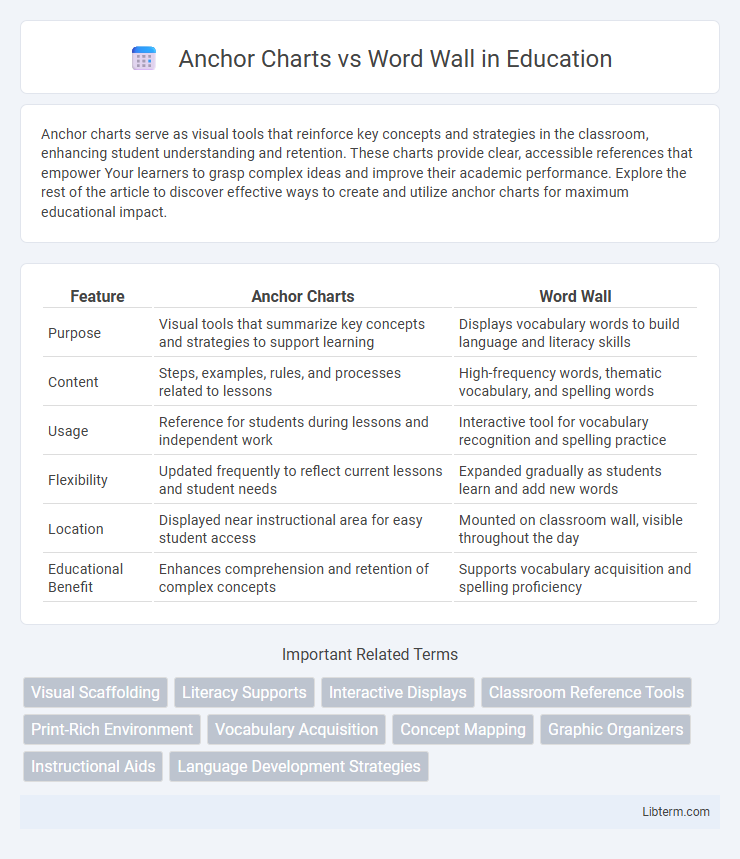Anchor charts serve as visual tools that reinforce key concepts and strategies in the classroom, enhancing student understanding and retention. These charts provide clear, accessible references that empower Your learners to grasp complex ideas and improve their academic performance. Explore the rest of the article to discover effective ways to create and utilize anchor charts for maximum educational impact.
Table of Comparison
| Feature | Anchor Charts | Word Wall |
|---|---|---|
| Purpose | Visual tools that summarize key concepts and strategies to support learning | Displays vocabulary words to build language and literacy skills |
| Content | Steps, examples, rules, and processes related to lessons | High-frequency words, thematic vocabulary, and spelling words |
| Usage | Reference for students during lessons and independent work | Interactive tool for vocabulary recognition and spelling practice |
| Flexibility | Updated frequently to reflect current lessons and student needs | Expanded gradually as students learn and add new words |
| Location | Displayed near instructional area for easy student access | Mounted on classroom wall, visible throughout the day |
| Educational Benefit | Enhances comprehension and retention of complex concepts | Supports vocabulary acquisition and spelling proficiency |
Introduction to Anchor Charts and Word Walls
Anchor charts and word walls are essential visual tools used in classrooms to enhance literacy and comprehension skills. Anchor charts serve as interactive references that display key concepts, strategies, and processes to support student learning and retention. Word walls organize and highlight vocabulary by categorizing words alphabetically or thematically, promoting word recognition and language development across various subjects.
Defining Anchor Charts: Purpose and Features
Anchor charts serve as visual learning tools designed to support student understanding by displaying key concepts, strategies, and processes in a clear, accessible format. They often feature collaboratively created content, combining text, images, and charts that reinforce classroom lessons and encourage active student engagement. The purpose of anchor charts is to provide ongoing reference points that help students internalize and apply knowledge independently.
Understanding Word Walls: Key Characteristics
Word walls are visual tools that display frequently used words or vocabulary, organized alphabetically to support literacy development and word recognition. They reinforce spelling patterns, phonics, and word usage, making them accessible references for students during reading and writing activities. Unlike anchor charts, which provide step-by-step instructions or concept explanations, word walls emphasize word storage and retrieval, enhancing vocabulary retention and fluency.
Differences Between Anchor Charts and Word Walls
Anchor Charts serve as dynamic visual tools that capture and display key concepts, strategies, and processes frequently referenced during lessons, fostering active engagement and reinforcement of learning. Word Walls are organized displays of vocabulary words arranged alphabetically or thematically to support word recognition, spelling, and language development, particularly in literacy instruction. The primary difference lies in Anchor Charts emphasizing concept explanation and procedural support, while Word Walls focus specifically on vocabulary acquisition and language reinforcement.
Benefits of Using Anchor Charts in the Classroom
Anchor charts enhance student learning by providing visual scaffolds that reinforce key concepts and strategies, promoting retention and independent problem-solving skills. Unlike word walls, anchor charts offer context-rich, multimodal references that support diverse learning styles and foster deeper understanding. They also facilitate interactive discussions and collaborative learning, empowering students to actively engage with and internalize content.
Advantages of Implementing Word Walls
Word walls enhance vocabulary acquisition by providing constant visual reinforcement of key terms, which supports memory retention and spelling accuracy for students. They create an interactive learning environment where students can easily reference and connect new words to prior knowledge, promoting language development. Implementation of word walls also fosters independent learning and encourages frequent engagement with essential academic language across subjects.
When to Use Anchor Charts vs Word Walls
Anchor charts are best used during lessons to visually capture and reinforce key concepts, strategies, or procedures in a flexible, interactive format that supports immediate reference and student engagement. Word walls excel in promoting vocabulary development and spelling by providing a permanent, organized display of high-frequency or subject-specific terms that students can consult repeatedly throughout a unit or school year. Choosing between anchor charts and word walls depends on whether the goal is ongoing concept reinforcement or long-term vocabulary retention within a classroom environment.
Best Practices for Creating Effective Anchor Charts
Effective anchor charts incorporate clear, concise visuals and key vocabulary to enhance student understanding and retention. Using large, legible text and engaging colors ensures information is accessible and memorable during lessons. Integrating student input while organizing content thematically supports active learning and scaffolds complex concepts efficiently.
Tips for Designing Engaging Word Walls
Effective word walls incorporate vibrant colors and organized categories to enhance visual appeal and facilitate quick word retrieval. Use interactive elements such as movable cards or tactile materials to engage students in active learning and reinforce vocabulary retention. Position the word wall at eye level and update it regularly to reflect current lessons, ensuring continuous student interaction and relevance.
Integrating Anchor Charts and Word Walls for Student Success
Integrating anchor charts and word walls enhances student success by combining visual supports that reinforce content understanding and vocabulary retention. Anchor charts provide structured, process-oriented information while word walls serve as dynamic reference tools for language development. Utilizing both tools together creates a comprehensive learning environment that promotes engagement, comprehension, and application of key concepts across subjects.
Anchor Charts Infographic

 libterm.com
libterm.com